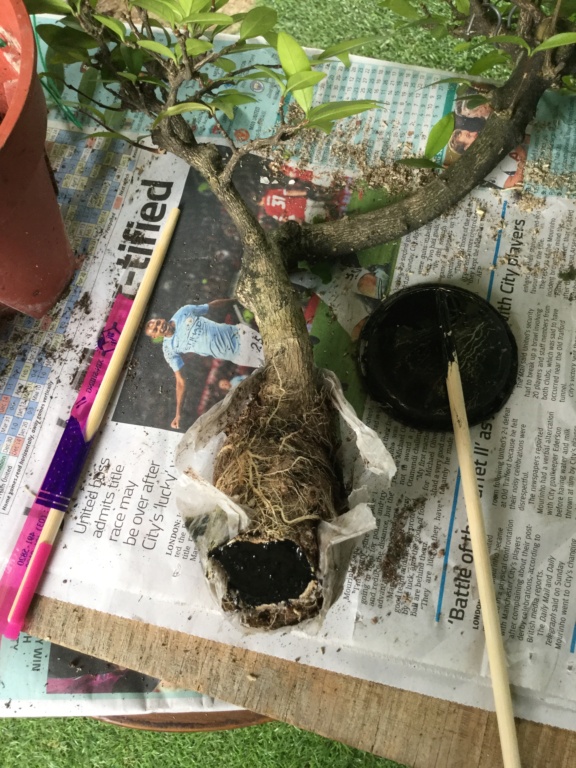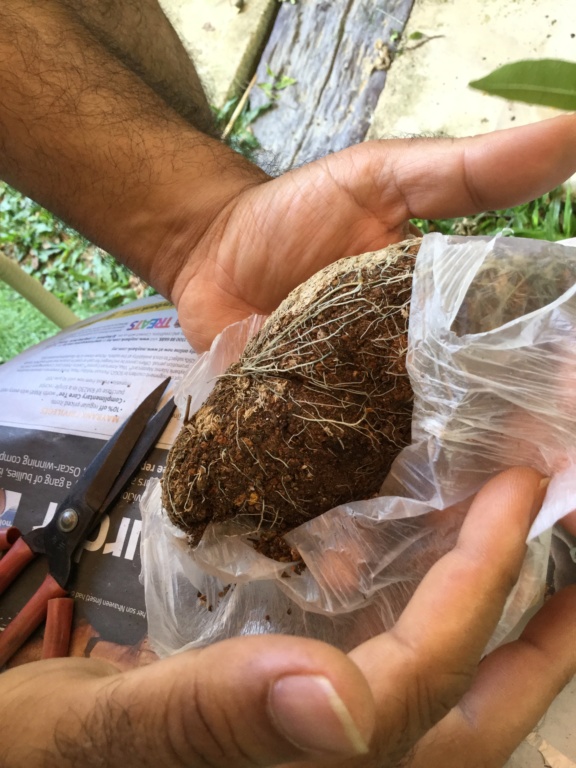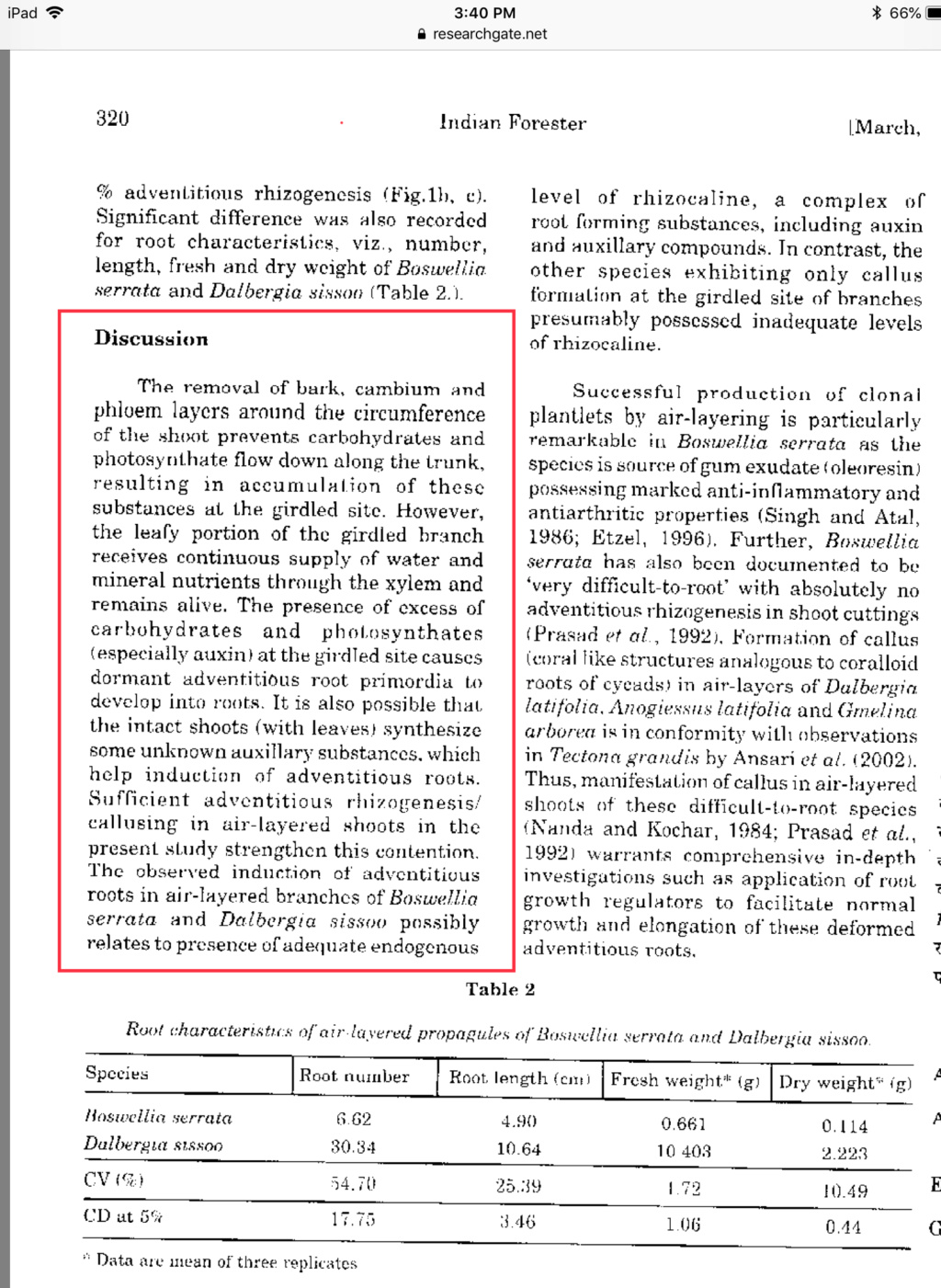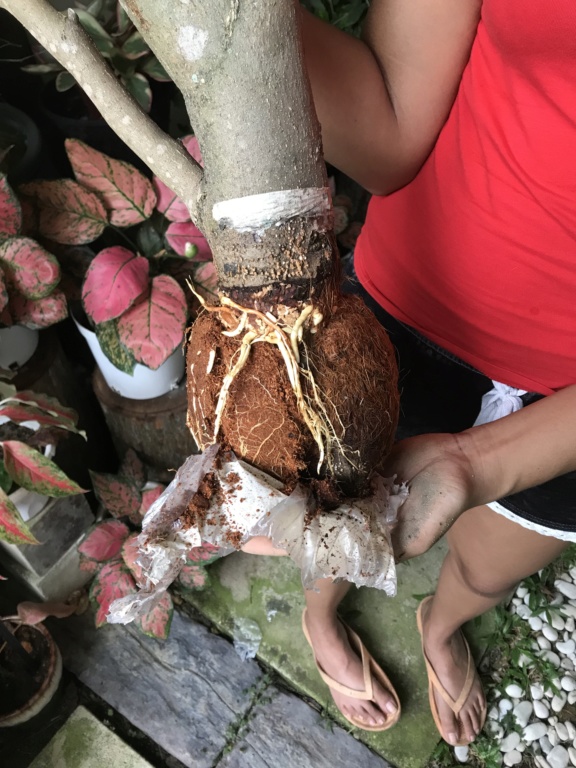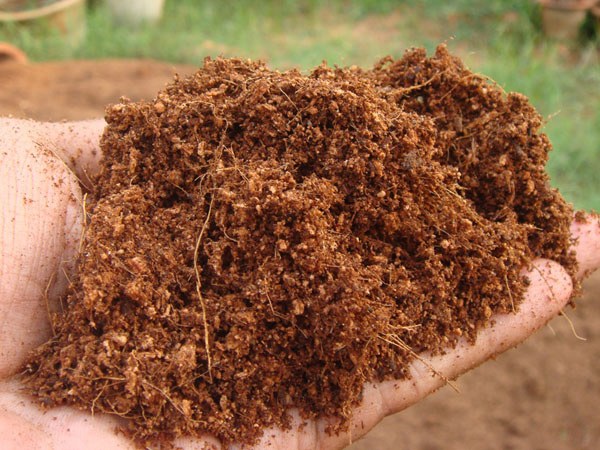Airlayering an apple tree
+2
M. Frary
Vitusus
6 posters
Page 1 of 1
 Airlayering an apple tree
Airlayering an apple tree
Hi all,
I decided to airlayer a few branches from my apple tree, so I cut the bark off in spring, applied the sphagnum moss and waited all spring and summer. Today, I was harvesting the apples from the tree and as I did not see any roots, I decided to look under the layer of moss. This is what I found:
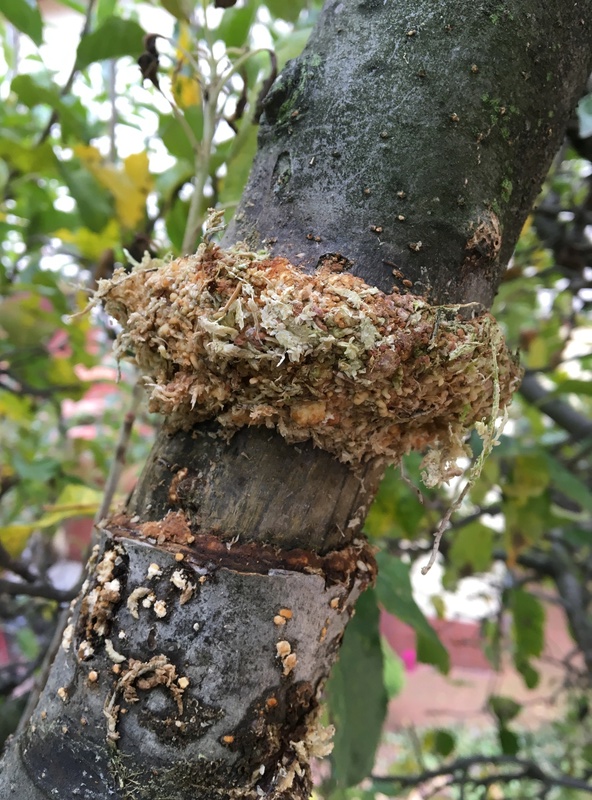
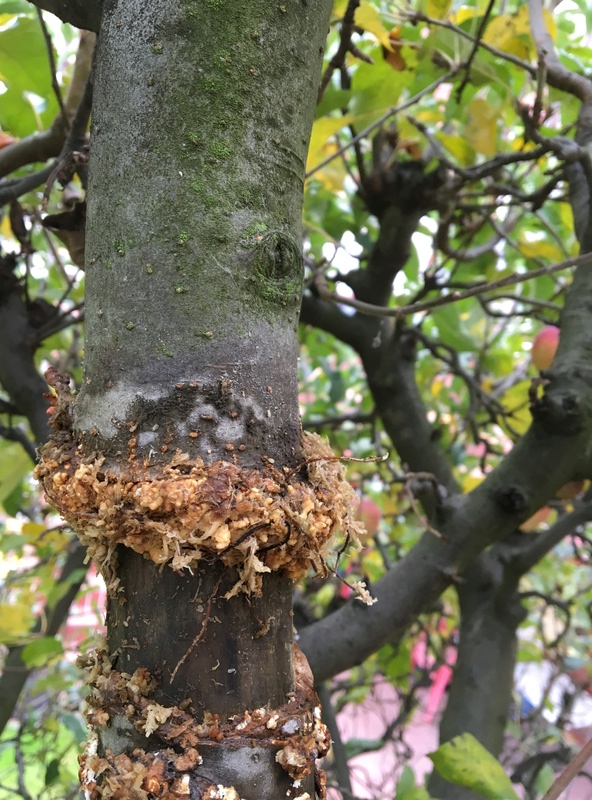
Now, I assume that this is what the tree did with all the sugars that the leaves produced during the season but what to do with it now? Will it produce the roots next year if I reapply the moss? Or should I cut all this off and reapply moss? And, most importantly, will it survive the winter if left like this?
Thanks for advice.
Vitusus
I decided to airlayer a few branches from my apple tree, so I cut the bark off in spring, applied the sphagnum moss and waited all spring and summer. Today, I was harvesting the apples from the tree and as I did not see any roots, I decided to look under the layer of moss. This is what I found:


Now, I assume that this is what the tree did with all the sugars that the leaves produced during the season but what to do with it now? Will it produce the roots next year if I reapply the moss? Or should I cut all this off and reapply moss? And, most importantly, will it survive the winter if left like this?
Thanks for advice.
Vitusus
Vitusus- Member
 Re: Airlayering an apple tree
Re: Airlayering an apple tree
Since it didn't bridge the gap with bark you need to remoss it in hopes of living.
The stuff you see on the bottom of the cut is where it wanted to grow roots and didn't.
The reason for that is I believe the layer was kept too moist. It formed that callous and sucked water from the moss. If it was too dry the top would be dead.
The stuff you see on the bottom of the cut is where it wanted to grow roots and didn't.
The reason for that is I believe the layer was kept too moist. It formed that callous and sucked water from the moss. If it was too dry the top would be dead.
M. Frary- Member
 Re: Airlayering an apple tree
Re: Airlayering an apple tree
It should be OK - as Mike has written cover again with foil filled with wet moss. The branch still gets water and nutrients via the vascular tissue in xylem. Do not forget to make some holes into the wrap on both sides - top & bottom. I would remove lover part of the callus in the late spring and dust the area with a rooting hormone to give it one more try.
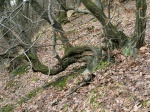
Vlad- Member
 Re: Airlayering an apple tree
Re: Airlayering an apple tree
Thank you guys, just one additional question, should I reapply moss now or should I wait till spring?
As Vlad suggest that I should cut a bit of it off in late spring, I would say to leave it as it is till spring and then cover with moss again? The top is alive and ok so far.
By the way, as it is like 3 meters high, I did not add any additional water through the whole season, so if it really was too wet then it was due to too much rain and not me
As Vlad suggest that I should cut a bit of it off in late spring, I would say to leave it as it is till spring and then cover with moss again? The top is alive and ok so far.
By the way, as it is like 3 meters high, I did not add any additional water through the whole season, so if it really was too wet then it was due to too much rain and not me
Vitusus- Member
 Re: Airlayering an apple tree
Re: Airlayering an apple tree
Get it covered as soon as possible. It needs to have the moss there to replace the calcium layer. Too long and it will dry out and die.
M. Frary- Member
 Re: Airlayering an apple tree
Re: Airlayering an apple tree
Just a quick update, I was checking the airlayers the other day and at least one of them produced some roots, so hopefully there will be enough of them by the end of summer, so that I can cut it off and let it recover in soil during autumn.
Vitusus- Member
 Re: Airlayering an apple tree
Re: Airlayering an apple tree
There is no hurry. I have left several airlayers ( not separated ) over two seasons. Just burried them deep enough over the winter to keep the fine roots protected.

Vlad- Member
 Re: Airlayering an apple tree
Re: Airlayering an apple tree
Thanks for the pictures, looks like your method is working very well. I think that the natural humidity levels are quite high in Malaysia compared to what we have here, so I still might be giving it some water from time to time, but as my airlayers are like 3m above ground, it's not an easy task to get the water up there 
But I will definitely take into the consideration the "darkness factor" next time, thanks for pointing this out.
But I will definitely take into the consideration the "darkness factor" next time, thanks for pointing this out.
Vitusus- Member
 Re: Airlayering an apple tree
Re: Airlayering an apple tree
With temps well above 20-23°C ( optimal temps range for roots in CE ) it is not very likely that the roots will be happy to develop/grow. They do need water, oxygen and the right temperature..

Vlad- Member
 Re: Airlayering an apple tree
Re: Airlayering an apple tree
Xylem is just a system of tubes to transfer water + nutrients from roots to leaves either by transpiration or by root pressure. Frankly, I doubt the new roots formed by airlayer can get some water from this source. They will get water + products created during photosynthesis via phloem. Is that enough to form strong, healthy root ball? No idea. Can new roots formed by an airlayer use this water again to pump it back to leaves? Sounds like a perpetuum mobile.
Anyway, I have never tried to airlayer without water. If you can do it, great. Always happy to learn new things. Nevertheles I will stick to my "wet process" in this specific case.
Btw, water can get into the substrate covered by a stretch foil just by "leaking" between the bark and the plastic during watering or rain. This is also one of the reasons to make drainage holes. Just my experience. Nothing else.
Thank you, Tony for your effort to share the interesting article.
Anyway, I have never tried to airlayer without water. If you can do it, great. Always happy to learn new things. Nevertheles I will stick to my "wet process" in this specific case.
Btw, water can get into the substrate covered by a stretch foil just by "leaking" between the bark and the plastic during watering or rain. This is also one of the reasons to make drainage holes. Just my experience. Nothing else.
Thank you, Tony for your effort to share the interesting article.

Vlad- Member
 Re: Airlayering an apple tree
Re: Airlayering an apple tree
Vlad wrote:Xylem is just a system of tubes to transfer water + nutrients from roots to leaves either by transpiration or by root pressure. Frankly, I doubt the new roots formed by airlayer can get some water from this source. They will get water + products created during photosynthesis via phloem. Is that enough to form strong, healthy root ball? No idea. Can new roots formed by an airlayer use this water again to pump it back to leaves? Sounds like a perpetuum mobile.
Anyway, I have never tried to airlayer without water. If you can do it, great. Always happy to learn new things. Nevertheles I will stick to my "wet process" in this specific case.
Btw, water can get into the substrate covered by a stretch foil just by "leaking" between the bark and the plastic during watering or rain. This is also one of the reasons to make drainage holes. Just my experience. Nothing else.
Thank you, Tony for your effort to share the interesting article.
This starts to look like an interesting discussion. From my limited knowledge of physics, I would say that the xylem which is used for transportation of water and nutrients will be connected from the roots newly created to the roots in the ground. And if these tubes are connected, then the osmotic pressure should do the trick and in the same manner the water goes up from roots in the ground to the leaves, it will go to the roots in the air. Theoretically.
However, as I said previously, I believe that the natural humidity conditions in Malaysia might be completely different from what we experience here in the Czech Republic, especially these days
Vitusus- Member
 Re: Airlayering an apple tree
Re: Airlayering an apple tree
I hope it is wrapped up in damp sphagnum again. I'd add a layer of bubble wrap to frost protect it, if you experience long freezing spells.
Apples and Crab Apples can be very reluctant rooters when air layering. Sometimes only one root forms and it is enough to sustain the tree after removal, but you can be left with a very ugly long term project. I would treat it as an experiment and try different rooting hormones on the cut surfaces when you unwrap them again in spring. Allowing the sun in to warm the moss ball has worked well for me in North Wales. If you are lucky enough to get good rooting please share the results.
Good luck
Apples and Crab Apples can be very reluctant rooters when air layering. Sometimes only one root forms and it is enough to sustain the tree after removal, but you can be left with a very ugly long term project. I would treat it as an experiment and try different rooting hormones on the cut surfaces when you unwrap them again in spring. Allowing the sun in to warm the moss ball has worked well for me in North Wales. If you are lucky enough to get good rooting please share the results.
Good luck

Kev Bailey- Admin
 Re: Airlayering an apple tree
Re: Airlayering an apple tree
Kev Bailey wrote:I hope it is wrapped up in damp sphagnum again. I'd add a layer of bubble wrap to frost protect it, if you experience long freezing spells.
Apples and Crab Apples can be very reluctant rooters when air layering. Sometimes only one root forms and it is enough to sustain the tree after removal, but you can be left with a very ugly long term project. I would treat it as an experiment and try different rooting hormones on the cut surfaces when you unwrap them again in spring. Allowing the sun in to warm the moss ball has worked well for me in North Wales. If you are lucky enough to get good rooting please share the results.
Good luck
Good information.
Some tree species are 'stubborn air layers'.
Cold weather changes humidity, which is vital for air layering.
Hormone aids and quickens the whole process.
Anyone else with more information?
Please share.
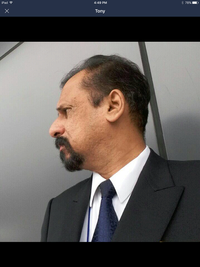
TonyRoch- Member
 WOW!
WOW!
I'm learning a lot of new stuff here. I have never layered any as big as I see here, and only in a greenhouse, and only soaking wet, so I'm at a loss for words. I've done Mesquite, Lysiloma, Laurel Oak, Bougainvillea, Serissa and others, but all ~tropical~.
Years ago, I bought some sets of "cups" with snap-on lids that have worked really well for me.
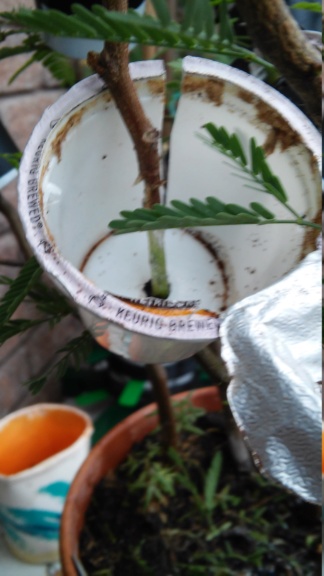
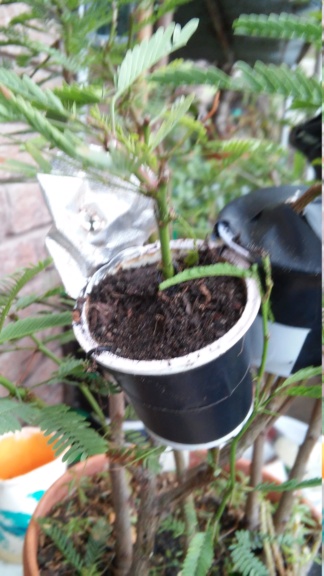
These are smaller than the commercial cups, and you can see they are free with a cup of coffee! I poke a hole the size of the branch in the bottom, slice them vertically so they snap on, use electrical tape to close the slit, wire them central to the branch, and fill with a homemade potting soil. The foil tops go back on and are taped in place such that there is a sizeable gap around the branch on top to allow water to generously drain into the cup.
Years ago, I bought some sets of "cups" with snap-on lids that have worked really well for me.



These are smaller than the commercial cups, and you can see they are free with a cup of coffee! I poke a hole the size of the branch in the bottom, slice them vertically so they snap on, use electrical tape to close the slit, wire them central to the branch, and fill with a homemade potting soil. The foil tops go back on and are taped in place such that there is a sizeable gap around the branch on top to allow water to generously drain into the cup.
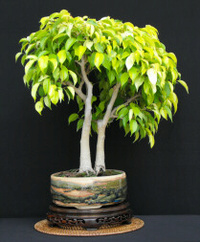
Michigander- Member
 WOW!, continued
WOW!, continued
I’ve only lost those individual cups that were perched badly and dried out, -that’s where the wire comes in. The cup top needs to be horizontal enough to get water into it. On larger branches, I use whatever works. Pop bottles cost you the deposit, 10 cents here. The commercial cups were not cheap. I like the clear vessel so I can see the roots. Usually, that’s under six weeks.
So, you can see that none of what I do corresponds to your dry, year-around system that works for you. Apparently, there’s more than one way to skin a cat.
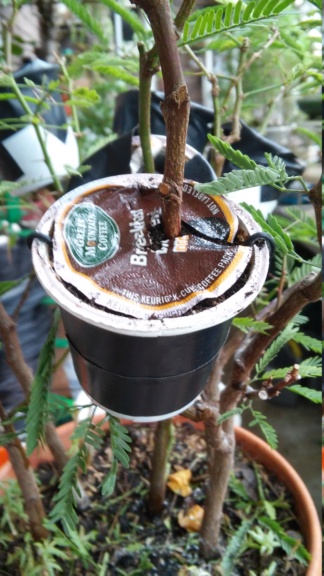

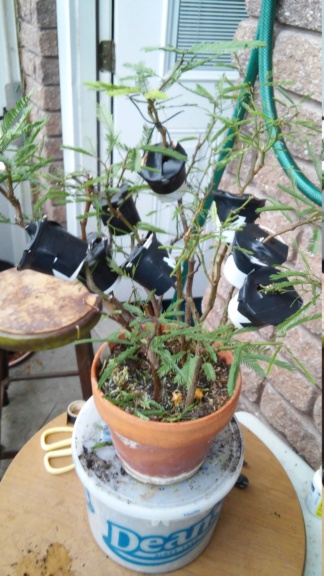
So, you can see that none of what I do corresponds to your dry, year-around system that works for you. Apparently, there’s more than one way to skin a cat.




Michigander- Member
 Re: Airlayering an apple tree
Re: Airlayering an apple tree
Hi all,
I thought I would hijack back my thread and gave you a little update of my project. I finally managed to separate the two airlayers last summer and though I managed to break the part of newly developed roots on one of the new trees
and gave you a little update of my project. I finally managed to separate the two airlayers last summer and though I managed to break the part of newly developed roots on one of the new trees  I decided to try my luck and pot both of them up. I let them do their thing during the rest of the summer/autumn and I was waiting for the spring to see whether it worked. And so now here is the result:
I decided to try my luck and pot both of them up. I let them do their thing during the rest of the summer/autumn and I was waiting for the spring to see whether it worked. And so now here is the result:

This one is already in full leaf and I removed all the flowers from it, so that it does not waste energy. And I am already starting to think about the design, I think some of the thick branches will have to be removed. But not this year, this year it will be only about growth.
The second one was looking quite dead for a long time and indeed some of the branches dried and died completely but in the end it is also coming:

I am quite happy and though these are just at the beginning of their bonsai route, I already like them a lot. Any tips health-wise or design-wise welcome. And yes, I know the pot could have been bigger, I just did not have anything bigger at hand.
I thought I would hijack back my thread

This one is already in full leaf and I removed all the flowers from it, so that it does not waste energy. And I am already starting to think about the design, I think some of the thick branches will have to be removed. But not this year, this year it will be only about growth.
The second one was looking quite dead for a long time and indeed some of the branches dried and died completely but in the end it is also coming:

I am quite happy and though these are just at the beginning of their bonsai route, I already like them a lot. Any tips health-wise or design-wise welcome. And yes, I know the pot could have been bigger, I just did not have anything bigger at hand.
Vitusus- Member
Gorilla likes this post
 Similar topics
Similar topics» Can this tree be a bonsai by airlayering?
» What variety of apple tree is this?
» Rotting Apple Tree
» Air layer an old apple tree?
» Airlayering Lilac
» What variety of apple tree is this?
» Rotting Apple Tree
» Air layer an old apple tree?
» Airlayering Lilac
Page 1 of 1
Permissions in this forum:
You cannot reply to topics in this forum







